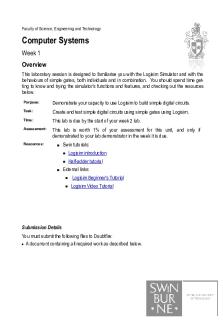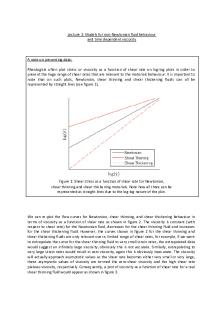Pressure Motion of Fluids PHET lab(1) (Complee) PDF

| Title | Pressure Motion of Fluids PHET lab(1) (Complee) |
|---|---|
| Author | Ryan Klebe |
| Course | Conceptual Physics |
| Institution | Gaston College |
| Pages | 3 |
| File Size | 115.3 KB |
| File Type | |
| Total Downloads | 112 |
| Total Views | 181 |
Summary
Name: _____________________________________ Period: ________Fluids LabMotion of Fluids phet.colorado/en/simulation/fluid-pressure-and-flow Enter the link above into the address bar. When the web page opens click “Run Now!” Above the spigot there is a sliding tab. Move the tab to the right to fill th...
Description
Name: _____________________________________
Period: ________
Fluids Lab Motion of Fluids http://phet.colorado.edu/en/simulation/fluid-pressure-and-flow 1. Enter the link above into the address bar. When the web page opens click “Run Now!” 2. Above the spigot there is a sliding tab. Move the tab to the right to fill the tank up completely with water. 3. In the top right corner of the window you can click and drag a pressure gauge to any location on the screen. The bottom of the gauge is the point where pressure is measured. 4. Measure and record the pressure of the water at the surface, in the middle, and at the bottom of the tank of water. 5. Write a statement about the relationship between pressure and depth in a liquid. As depth increases, pressure increases also 6. Click the “Flow” tab at the top of the window. In the top right corner there are pressure and speed gauges that can be dragged to any location on the screen. Clicking the check box next to “Ruler” in the yellow box at the top right of the screen will cause a ruler to appear. 7. Measure and record the diameter of the pipe as well as the pressure and speed of the water flowing through the pipe. Diamiter-2m Speed- 2.6m/s Pressure- 129.328kPa 8. The handles on various parts of the pipe can be clicked and dragged to change the diameter of the pipe at each location. Manipulate the pipe diameter at different locations so that one part has a very narrow diameter and the other part has a wide diameter. 9. Measure and record the diameter, speed, and pressure at a point where the pipe is very narrow and at a point where the pipe is very wide. Diameter- 1m Speed- 6.4m/s Pressure- 120.293kPa Diameter- 4m Speed- 0.4m/s Pressure- 136.003kPa 10. Write a statement about the relationship between the diameter of a pipe and the speed of the fluid flowing through it. The smaller the pipe, the faster the liquid flows 11. Write a statement about the relationship between the speed and pressure of a fluid in motion.
Fluids Lab
The faster the liquid moves, the lower the pressure
Fluid Mechanics Laboratory http://phet.colorado.edu/en/simulation/fluid-pressure-and-flow 1. Determine the absolute pressure two meters underneath a 1200 kg/m 3 density fluid under normal earth gravity and atmosphere. Use atmospheric pressure of 101 kPa. Show your work below, then use the simulation (under the “Pressure” tab) to get an experimental value. Calculate experimental error.
a. Calculated Pressure (Theoretical) ___124.52kPa____________________ b. Simulated Pressure (Experimental) ___125.1kPa_____________________ c. Experimental Error _____1.42kPa_______ 2. A fluid of density 1200 kg/m 3 flows out through a 2 meter diameter pipe without friction at a rate of 3000 L/s. Find the velocity of the fluid as it flows out of the pipe, and the velocity of the fluid if the pipe constricts to a diameter of 1 meter. Then calculate the change in pressure (in the middle of the pipe) between the 2 meter and 1 meter diameter. Using the simulation (under the “Flow” tab) determine experimental values for each of these velocities/change in pressures and calculate experimental error. Show your work.
a. b. c. d.
Calculated initial velocity _________0.955___________ Experimental initial velocity ___________________________ Experimental Error __________________________ Calculated final velocity _____3.82________________
Fluids Lab e. f. g. h. i.
Experimental final velocity ________________________ Experimental Error _______________________ Calculated change in pressure __8208______________________ Experimental change in pressure _________________________ Experimental Error _______________________
3. A 10 meter tall tank open to the air is filled with a fluid with a density of 1200 kg/m 3. It is located with its bottom 10 meters off the ground. When a hole is open at the bottom, fluid sprays out with an initial horizontal velocity. Determine how far (initially) the fluid sprays horizontally before it touches the ground. Find an experimental value for this experiment using the “Water Tower” tab and determine an experimental error. Show your work below.
a. Calculated horizontal range __________19.9________________ b. Experimental horizontal range _________24.25_________________ c. Experimental error for the range ________4.39________________ 4. Using the three experiments above as models, write out your own question to solve for below. You do not need to solve it, but it should be solvable....
Similar Free PDFs

Mechanics OF Fluids notes
- 37 Pages

Lab1
- 1 Pages

Lab1
- 5 Pages

Centre of pressure report
- 7 Pages

Lab1
- 8 Pages

Models of non-Newtonian fluids
- 6 Pages

Ph values of body fluids
- 4 Pages

Nature OF Motion - hdhdhhd
- 4 Pages

Mathematics of Circular Motion
- 3 Pages
Popular Institutions
- Tinajero National High School - Annex
- Politeknik Caltex Riau
- Yokohama City University
- SGT University
- University of Al-Qadisiyah
- Divine Word College of Vigan
- Techniek College Rotterdam
- Universidade de Santiago
- Universiti Teknologi MARA Cawangan Johor Kampus Pasir Gudang
- Poltekkes Kemenkes Yogyakarta
- Baguio City National High School
- Colegio san marcos
- preparatoria uno
- Centro de Bachillerato Tecnológico Industrial y de Servicios No. 107
- Dalian Maritime University
- Quang Trung Secondary School
- Colegio Tecnológico en Informática
- Corporación Regional de Educación Superior
- Grupo CEDVA
- Dar Al Uloom University
- Centro de Estudios Preuniversitarios de la Universidad Nacional de Ingeniería
- 上智大学
- Aakash International School, Nuna Majara
- San Felipe Neri Catholic School
- Kang Chiao International School - New Taipei City
- Misamis Occidental National High School
- Institución Educativa Escuela Normal Juan Ladrilleros
- Kolehiyo ng Pantukan
- Batanes State College
- Instituto Continental
- Sekolah Menengah Kejuruan Kesehatan Kaltara (Tarakan)
- Colegio de La Inmaculada Concepcion - Cebu






